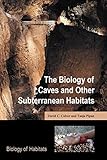The biology of caves and other subterranean habitats David C. Culver, Tajan Pipan
Tipo de material: Libro
impreso(a)
Idioma: Inglés Series Detalles de publicación: Oxford Oxford University Press 2009Descripción: xvi, 254 páginas fotografías, ilustraciones, mapas 23 centímetrosISBN:
Libro
impreso(a)
Idioma: Inglés Series Detalles de publicación: Oxford Oxford University Press 2009Descripción: xvi, 254 páginas fotografías, ilustraciones, mapas 23 centímetrosISBN: - 0199219931
- 9780199219933
- 578.7584 C8
Incluye bibliografía: páginas 221-246 e índice: páginas 247-254
Glosario: páginas 215-220
Site Maps and Gazetteer.. 1. The Subterranean Domain.. 2. Sources of Energy in Subterranean Environments.. 3. Survey of Subterranean Life.. 4. Ecosystem Function.. 5. Biotic Interactions and Community Structure.. 6. Adaptations to Subterranean Life.. 7. Colonization and Speciation in Subterranean Environments.. 8. Geography of Subterranean Biodiversity.. 9. Some Representative Subterranean Communities.. 10. Conservation and Protection of Subterranean Habitats.. Glossary.. References.. Index
Caves and other subterranean habitats with their often strange (even bizarre) inhabitants have long been objects of fascination, curiosity, and debate. The question of how such organisms have evolved, and the relative roles of natural selection and genetic drift, has engaged subterranean biologists for decades. Indeed, these studies continue to inform the more general question of adaptation and evolution. However, interest in subterranean biology is not limited to questions of evolutionary biology. Both the distribution and the apparent ancient age of many subterranean species continue to be of significant interest to biogeographers. Subterranean ecosystems generally exhibit little or no primary productivity and, as "extreme" ecosystems, provide general insights into ecosystem function. Furthermore, the simplicity of subterranean communities relative to most surface-dwelling communities makes them useful model systems for the study of species interactions such as competition and predation, as well as more general principles of ecosystem function. The rarity of many cave species makes them of special interest in conservation biology. The Biology of Caves and other Subterranean Habitats offers a concise but comprehensive introduction to cave ecology. While there is an emphasis on the organisms that dominate this unique environment, conservation and management aspects are also considered. The book includes a global range of examples and case studies from both caves and non-cave subterranean habitats; it also provides a clear explanation of specialized terms used by speleologists. This accessible text will appeal to researchers new to the field and to the many professional ecologists and conservation practitioners requiring a concise but authoritative overview. Its engaging style will also make it suitable for senior undergraduate and graduate students taking courses in cave and subterranean biology. Inglés


